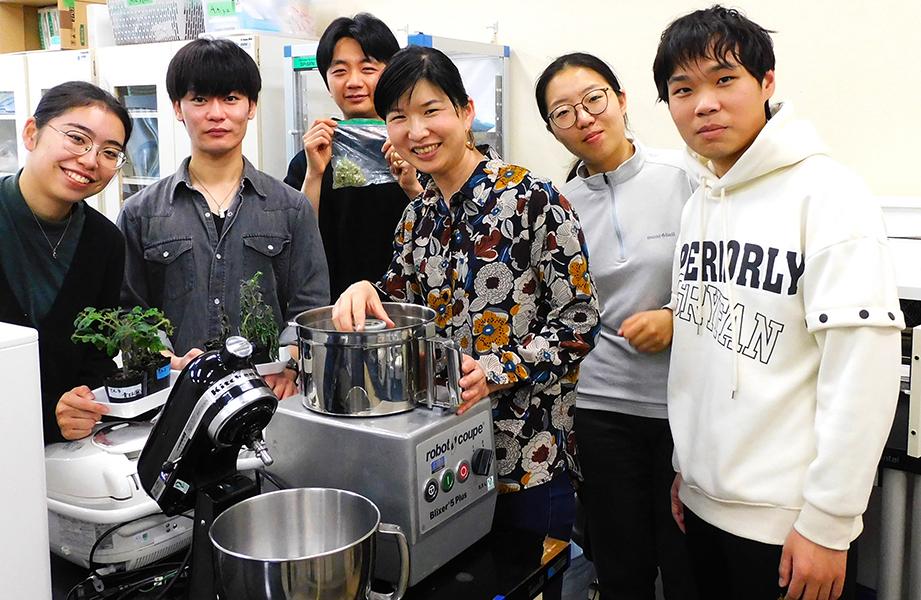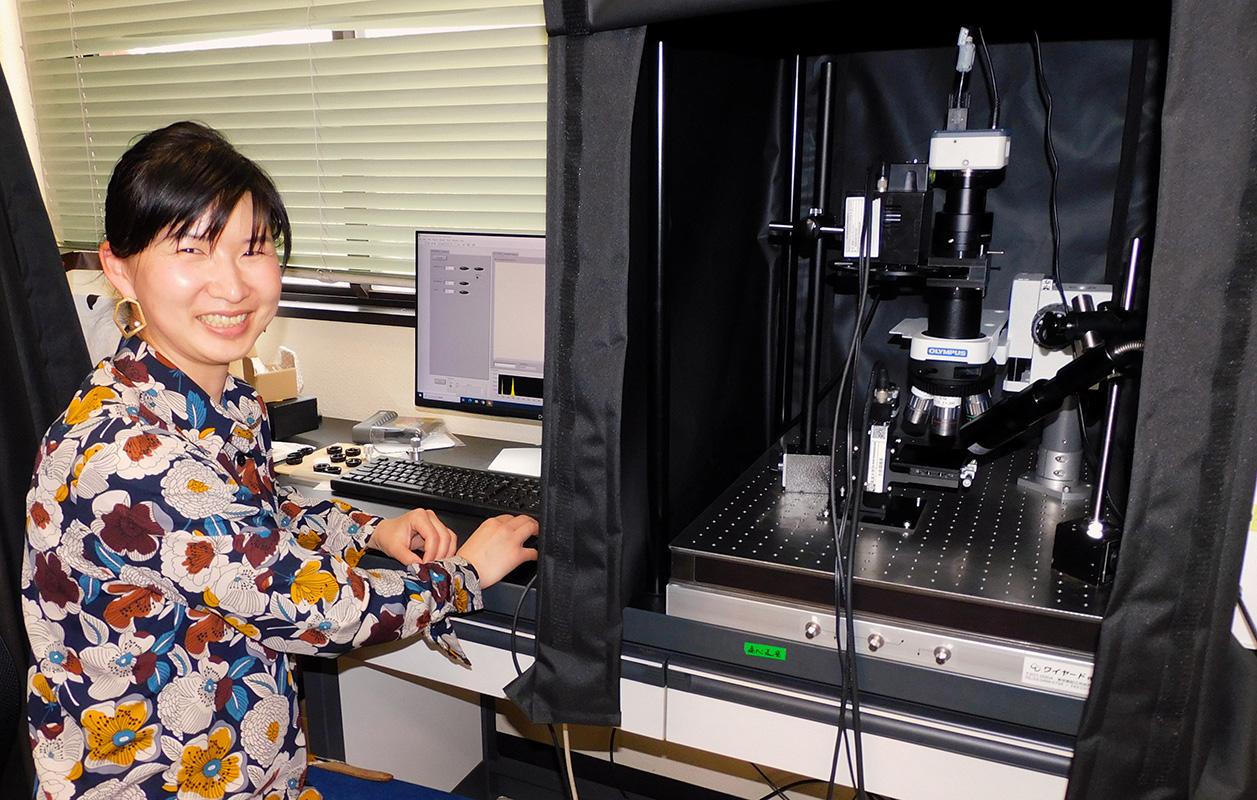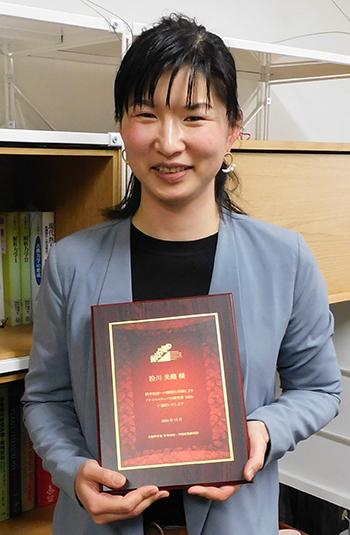TSUKUBA FUTURE
#126 Evaluating Food Palatability Without Actually Eating It
Associate Professor KOKAWA Mito, Institute of Life and Environmental Sciences

Have you ever seen labels that say, "Premium melon with a sugar content of 18 degrees or higher"? Sugar content labels are also common on watermelons and other fruits. They are a factor in consumers' purchasing decisions. But how can you tell how sweet a melon or watermelon is without eating it?

With students in the lab. Various cooking utensils are also essential for research.
Such an assessment is possible through a technology called nondestructive evaluation. For example, near-infrared light is used to determine the sugar content of melons and watermelons because sugar can absorb near-infrared light. Therefore, melons and watermelons are irradiated with near-infrared light, and the amount of light transmitted through the fruit is measured. A lower transmittance means that more light is absorbed, which indicates that the fruit has a high sugar content.
During her graduate studies, Professor KOKAWA began studying the nondestructive evaluation of food products when she joined a food engineering laboratory under the Faculty of Agriculture. Initially, she entered university to study architecture with the Faculty of Engineering; however, her plans changed. As an undergraduate, Professor KOKAWA was active in the university's rowing club, placing 6th in the doubles (two rowers) at the All-Japan Championships and 8th in the quads (four rowers) at the All-Japan University Rowing Championships during her senior year. She says, "The main reason I transferred to the Faculty of Agriculture was because the assignments in the Department of Architecture were taking too much of my rowing time (lol). Although the shift was for a nonacademic reason, I was able to use my knowledge in engineering and apply it to foods. Sometimes, things work out in the end."
Light is an important tool in nondestructive evaluation. The absorption,
fluorescence, and scattering of light at different wavelengths, from
ultraviolet to near-infrared, can be measured to determine the composition and
microstructure of the food without destroying it. In analyzing food
components, components are commonly extracted using organic solvents; however
, Professor KOKAWA says, "I would like to focus on examining the food as a
whole." Furthermore, when a component is extracted and examined, it may not be
fully extracted. Occasionally, some components can even be destroyed during
the extraction process. With nondestructive evaluation, such concerns are
basically eliminated. It is a method that enables the evaluation of the true
"palatability" of a food without eating it. In addition, conventional chemical
analysis generates waste liquid, which is troublesome to dispose.
Nondestructive evaluation generates no waste liquids. Besides, the short
measurement time offers a significant advantage.

Professor KOKAWA with the fluorescence fingerprint imaging device.
Professor KOKAWA's first challenge was to research and develop the fluorescent
fingerprint (FF) method.
Fluorescence is a phenomenon in which a substance absorbs light and then
releases the energy back into the atmosphere as light. Proteins and
polyphenols in foods can emit fluorescence. The wavelength and intensity of
the emitted fluorescence vary according to the type of substance and light
irradiation. When food is irradiated with light of various wavelengths, and
the fluorescence released in response to each wavelength is superimposed and
analyzed in three dimensions, a pattern resembling a fingerprint emerges,
allowing us to identify the components of the food.
Taiwanese mangoes had been passed off as Okinawan mangoes in the past.
However, Professor KOKAWA and her team succeeded in differentiating between
the mangoes using the FF method.
In December 2023, Professor KOKAWA developed a method for accurately
determining the total amount of active ingredients (polyphenols, flavonoids,
etc.) and properties, such as antioxidant capacity, in spice extracts by
combining the FF method with machine learning techniques and published a paper
on this topic.
Light scattering is a phenomenon in which light hitting a substance changes
its direction. Professor KOKAWA and her colleagues successfully verified the
firmness and texture of apples and pears by irradiating the fruits with laser
light and examining the degree of scattering. The firmness and texture of
fruits are related to the microstructure of pulp, such as the fiber
components. The degree of laser light scattering changes with the
microstructure. Many experiments have demonstrated the relationship between
light and microstructure.
Professor KOKAWA and her colleagues are also developing a method for visualizing the cheese ripening process by determining
absorption, fluorescence, and scattering.
During cheese ripening, casein, a protein in milk, is broken down into free amino acids. Simultaneously, milk
fat is broken down into free fatty acids. Lipids are oxidized, and the
Maillard reaction, which produces colored substances from free amino acids and
sugars, progresses. These changes were captured by combining the FF method and
measurement of near-infrared absorption changes. In addition, through laser
scattering, changes in hardness can be estimated.
Last year, the National Institute of Science and Technology Policy of the
Ministry of Education, Culture, Sports, Science and Technology selected
Professor KOKAWA as one of the 10 Nice Step Researchers 2023 to bring energy
to Japan. "I didn't expect to receive this award, but I am happy that what I
have done has been recognized," she said. She is genuinely an "in-season"
researcher.

Professor KOKAWA holding a Nice Step Researcher selection certificate.
The fridge in Professor KOKAWA's lab is filled with cheese, apples, and
butter, and the storage room has rice, bread, and various spices. Her
laboratory looks more like a restaurant than a research laboratory.
Professor
KOKAWA is now trying to develop a method that combines microscopy and laser
light to quantify substances in food within a few thousandths of a millimeter.
In the nondestructive evaluation of food using light, signals from multiple
components in an object are emitted simultaneously, which makes the
identification of components difficult. Once a new method, called "Spatially
Factorized Spectroscopy " is established, it will enable the separation of
specific information from multiple components.
Omics is a field of study that comprehensively analyzes the molecules that
compose living organisms. Genomics refers to the study of genes, whereas
proteomics refers to the study of proteins. Professor KOKAWA's goal is to
establish "spectromics," which is the comprehensive measurement and evaluation
of the optical characteristics (spectrum) of an object. Visualization of
cheese ripening by combining absorption, fluorescence, and scattering of light
is one example of spectromics. Above and beyond her numerous achievements,
Professor KOKAWA continues to work toward realizing her dream of "making it
possible to create a nondestructive evaluation table of food ingredients."
Article by Science Communicator at the Bureau of Public Relations
Related Link
Associate Professor KOKAWA Mito
Institute of Life and Environmental Sciences


